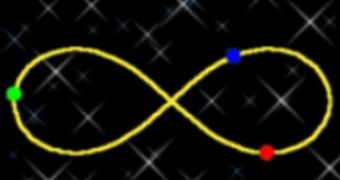It may sound strange, but Newton's theory of gravity predicts that it would be possible for three planets with equal masses to race around one another in a strange looking orbit the shape of figure 8. Einstein's more accurate theory of gravity, general relativity, was not sure to support such a weird orbit.
If a sum of strange space coincidences were to bring two planets to cling to each other through gravity, one would orbit the other by tracing an ellipse over and over. Moreover, if even more space oddities, or a creator's will, you choose, were to throw together three or more planets, their interactions would become so complex that chaos would reign.
In fact, our solar system remains orderly because the sun is so heavy that each planet follows its lead and more or less ignores the other planets. Theoretic physicists like playing with the "what if" concept, like Cristopher Moore of the University of New Mexico in Albuquerque, who, in 1993, discovered that if he set things up just right, then according to Newton's theory, three equal-mass planets could chase each other endlessly in a figure 8.
However, Einstein's theory could have demolished these predictions, as it says that gravity is actually the warping of space and time themselves and it makes small but profound changes to the predictions of Newton's theory.
It says, for instance, that when one planet orbits another space body, the orbit of the first will slowly turn, like the hour hand on a clock, to produce a complicated flowerlike pattern that doesn't repeat. Moreover, once Einstein had completed the theory, he immediately showed that it could account for the theretofore unexplained turning of the orbit of Mercury. In theory, the strange figure-8 orbit should suffer from similar distortions.
Now, scientists Tatsunori Imai, Takamasa Chiba and Hideki Asada at Hirosaki University in Japan have discovered that they can fiddle with the precise starting points and velocities to compensate for the distortions, thus keeping the planets on the figure-8 orbit, at least in the short term.
They used computer simulations to calculate the precise orbit and found that the planets follow that orbit for at least 10 cycles. The analysis is the first to show that such an oddball orbit is possible in Einstein's universe.
The lack of stability of the strange orbit is caused by the fact that Einstein's theory says the circulating planets should also produce ripples in space and time that will gradually carry away the planets' energy, thus eventually interrupting the cycle, but one has to admit that it's a nice looking oddity of the Universe.

 14 DAY TRIAL //
14 DAY TRIAL //